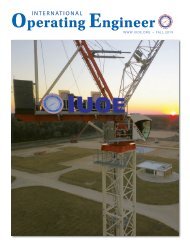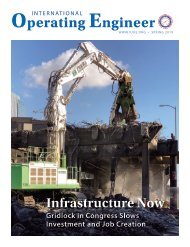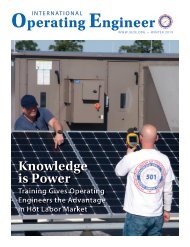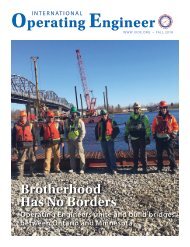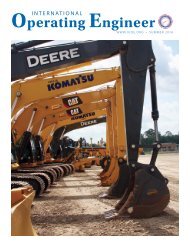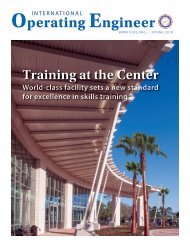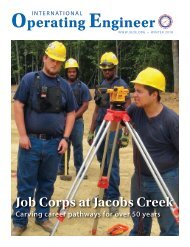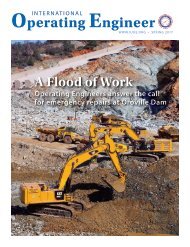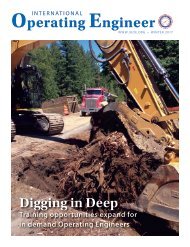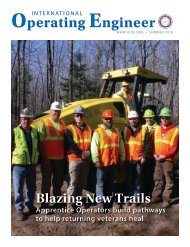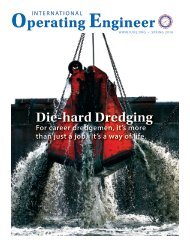125 Years Strong – An IUOE History
Celebrating the 125th Anniversary of the founding of the International Union of Operating Engineers
Celebrating the 125th Anniversary of the founding of the International Union of Operating Engineers
Create successful ePaper yourself
Turn your PDF publications into a flip-book with our unique Google optimized e-Paper software.
INTERNATIONAL UNION OF OPERATING ENGINEERS<br />
involved 50 industrial contractors, was<br />
implemented to shorten construction time<br />
requirements on heavy industrial projects,<br />
contain costs and provide greater stability in<br />
the industry. (2) Later addressing the agreement,<br />
General President Turner told attendees at<br />
the 1984 I.U.O.E. Convention, “The pact is<br />
openly and frankly a response by the unionized<br />
sector of the construction industry to recent<br />
open-shop advances in the area of industrial<br />
plant construction and preserving jobs for<br />
union members.”<br />
I.U.O.E. Local No. 793 operators work on<br />
construction of the SkyPod portion of the CN Tower<br />
in Toronto, which when completed in 1976 was the<br />
world’s tallest free-standing structure until 2007.<br />
Members of I.U.O.E. Local No. 793 in Ontario, Canada, excavate<br />
the site for construction of the CN Tower in Toronto circa 1973.<br />
Into and through 1978, the union and much of<br />
the country were still feeling the lingering effects<br />
of the 1973-1975 recession and its so-called<br />
“stagflation,” in which high unemployment and<br />
high inflation existed simultaneously. Despite<br />
improvements to the economy and construction<br />
Graduating apprenticeship class of I.U.O.E. Local No. 99 of Washington, D.C., in 1973.<br />
employment, union members all around<br />
North America were still concerned about jobs,<br />
manpower, and the costs of living. “We still face<br />
the overall inflation situation,” President Turner<br />
wrote to the membership in the November 1978<br />
International Operating Engineer, “and labor<br />
families are the first to face its devastating effects.”<br />
During the final years of the 1970s, among<br />
the major projects I.U.O.E. locals handled,<br />
Local No. 400 was instrumental in the fouryear<br />
construction of the largest air-cooled<br />
power plant in the world, the 330,000-kilowatt<br />
Wyodak Power Plant near Gillette, Wyoming,<br />
which was completed in 1978. The following<br />
year, operating engineers from Local No. 370<br />
in Spokane, Washington, became the first<br />
to make a lift with the world’s largest, landtransportable<br />
mobile crane, the Neil F. Lampson<br />
company’s Transi-Lift. The members used the<br />
mammoth crane, with a 340-foot boom, a<br />
190-foot mast and a capacity of 2,000 tons, to<br />
lift a 1,100-ton nuclear reactor pressure vessel<br />
280 feet to place it in a containment building at<br />
the under-construction U.S. Hanford Nuclear<br />
Reservation in southern Washington state’s<br />
Benton County.<br />
Then in 1979 during the 60 th Convention of<br />
the A.F.L.-C.I.O. Building and Construction<br />
Trades Department in San Diego, the I.U.O.E.<br />
and other building-trades unions launched a<br />
massive offensive against the nation’s “union<br />
busters,” who for years had been working to<br />
put organized construction craftspeople out of<br />
work and reduce their collective standard of<br />
living. The I.U.O.E. delegates at the convention<br />
gave a strong, united voice to the campaign<br />
against, as the December 1979 International<br />
Operating Engineer described them, “unionbusting<br />
contractors, their right-wing political<br />
puppets and the corporations that have been<br />
masterminding the conspiracy to turn the entire<br />
industry into a low-wage, open-shop empire.”<br />
Training to Make a Comeback<br />
Throughout much of the first half<br />
of 1980s, the I.U.O.E. and most<br />
building-trades unions struggled in the<br />
throes of a severe economic depression that<br />
engulfed the country during the first nearly<br />
four years of the decade and a continuing<br />
anti-union environment. As a result, into the<br />
second half of the decade, membership growth<br />
LABOR OMNIA VINCIT<br />
WORK CONQUERS ALL




